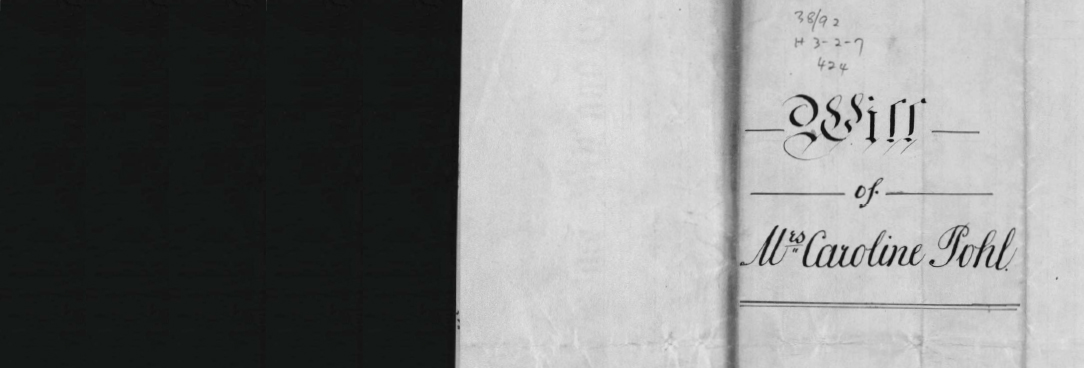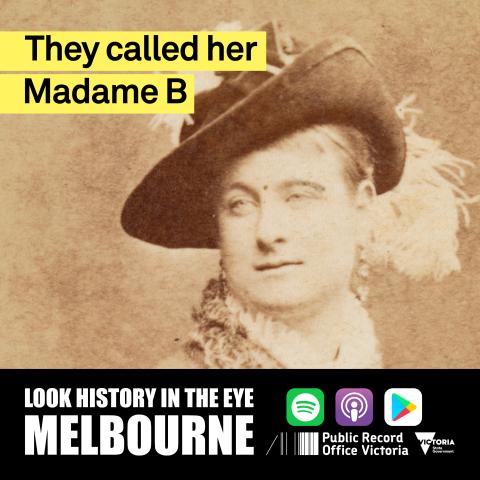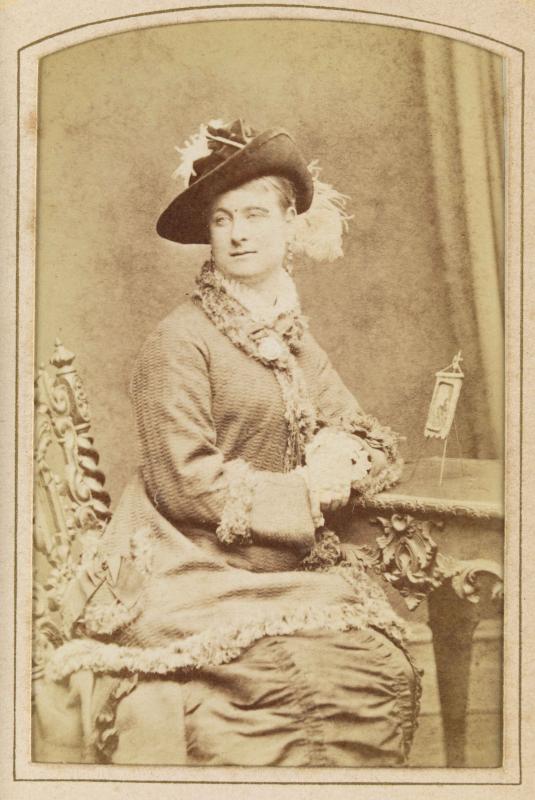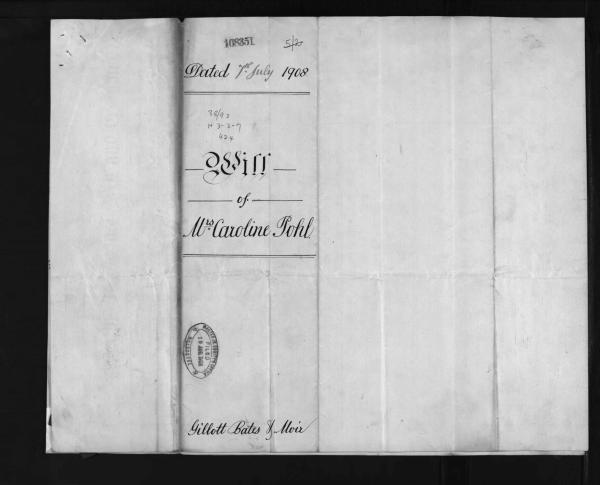Transcript Episode 3: They called her Madame B
Duration 26min
From the podcast series ‘Look History in the Eye’
Written, produced and presented by Kate Follington and Public Record Office Victoria
Music and sound design by Jack Palmer
Guests: Historian, Barbara Minchinton and Urban Archaeologist, Sarah Hayes of the Deakin Institute
Kate Follington
In early 2018 Denis James, from Sydney Australia received a phone call from historian Barbara Minchinton, she wanted to ask him about his great great Grandmother Lizzie Jane Hodgson. She’d been researching his family history for months.
Denis James
I read online an article called Sex and The Sisterhood. There was an article about Little Lon or the Lonsdale Street district, I knew nothing of it, but there was a map, and on the map there was a listing of all the houses along there, and I had a folder, of letters and so forth and some of them were address to the properties there. So I contacted both Sarah and Barbara and Barbara ended up contacting me.
The phone call led to a very colourful character from Melbourne’s history finally being understood for the first time.
Denis James
She asked, were there any photos? And I explained no I didn’t think so, and then it dawned on me that I had given a photo album to my niece, more of a decorative thing. They were just Victorian photos, Victorian studio photos really, and we went through where they’d been taken, Grafton, and Melbourne, and then I said, oh this one has been taken in Brussels. And, she was incredibly quiet on the other end of the phone.”
Hi, my name’s Kate Follington and you’re listening to the Podcast Look History in the Eye produced by Public Record Office Victoria, the archive of the state government of Victoria. One hundred kilometres of public records about Victoria’s past are carefully preserved in climate controlled vaults. We meet the people who dig into those boxes, look history in the eye, and bother to wonder, why. You can download the record that began this story by searching Look History in the Eye podcast online.
The photo album contained portraits of Lizzie Jane, which was expected, but the real object of Barbara’s interest was not Lizzie but her sister in law, one of Lizzie’s best friends. A familiar name in Melbourne’s night scene. There’s an alleyway named after her, a popular rooftop bar adorned with garden chairs serving pastel pink cocktails named in her honour.
but until Barbara traced her family history to Denis in 2018 no one knew what Caroline looked like, or very much about her at all…really. We’d simply known her as Madame Brussels, the infamous Flash Madam who serviced the top end of town in the late 19th Century.
Rumour had it – there was a tunnel linking her brothel to the state parliament, and that the parliamentary mace went missing one night when a client was partaking in too much kinky fun, but today we put the rumours to rest….and we meet the real woman behind Australia’s most extravagant 19th century brothel.
This story begins with Caroline Hodgson’s will.
Barbara Minchinton
“It described in her will that she had left her estate to her adopted daughter. Well, A morally putrescent prostitute is hardly likely to adopt a daughter and then to have looked after her to the point where she’s raised her and left her her entire estate. So it raised some questions for me: Who was this woman? And what kind of things did she do apart from running these famous brothels? Once I had the name of the daughter, which I obtained from her probate documents, I was able to trace the life of this young woman.”
Madame Brussel’s real name was Caroline. She was just 20 years old when she arrived in Melbourne. And it wasn’t long before she was a well known name around an area called Little Lon, known mostly for its brothels. A cartoon sketched in the newspapers at the time, portrayed her as an immoral witch-like figure that had become the accepted image of Madame Brussels. The truth however, is quite different.
Barbara Minchinton
They called her the Princesses of procuress’s, they called her the queen of harlotry, this morally putrescent prostitute, a moral monster, hellish harridan, feculent fiend in human form, this disgusting drab, this wicked woman.
Kate Follington
These degrading comments about Madame Brussels have set the tone for how she was known ever since. Even the garden bar named after her continues to use these images in their marketing materials, even though we now know it’s quite inaccurate.
One of the photos in the album is a beautiful portrait in sepia of a young petite confident woman with a round gentle face, and she stares back at us, she calmly leans her elbows onto a fake stone railing, a photo of a stone bridge is in the background, her spiralled hair is pinned back with a bow on top of her head and locks of curly hair fall casually over her shoulders. A velvet choker is tied around her neck and her Victorian 1880s bustle dress, is tight at the waist but billows out behind her with layers of silk, emphasising an over-padded buttocks. Caroline is dressed in the latest European fashion, and if I’m correct in dating it to the 1880s, at that time she was one of the wealthiest business women in Melbourne. Not bad for a single woman in her thirties living in a colonial outpost on the other side of the world.
Barbara Minichinton
The importance of the photos they provide us with a number of things, the earliest of the photos, she’s looking quite simply dressed, it’s not a complex outfit she’s wearing, but the latest ones, when she was operating her high-end brothels are beautifully sewn, quite complex pieces, they’re obviously silk.
There is a story that the family provided us with about when she used to go to Sydney to visit her sister in law, she was very close to her sister in law. And her sister in law had a little girl, and at a certain point the sister in law decided to come down to Melbourne to visit, and they were in a first class carriage. And who should be sitting along-side them but Nellie Melba, and she commented on this woman’s jewellery and how lovely her jewellery was, and so I think we can take it from that she travelled in the best of circles.
Kate Follington
She arrived in Melbourne in the 1870s which was the perfect time for success.
By 1860 Melbourne had gone from being a little known colony in the antipodes way off in the Southern ocean, to a City that exported two tonnes of gold a week back to England to pay off its global debt. The population of Victoria went from 70,000 people to over half a million in a decade, it goes without saying that a port city like Melbourne flush with the production of gold attracted European investors, entrepreneurs and really savvy intelligent businesswomen. And Caroline Hodgson sat among it. She was running a high end brothel servicing the wealthy men of Melbourne. The politicians, the landholders, the men with power.
Barbara Minchinton
Caroline Hodgson was born in Germany, she married an Englishman, she describes her father as a gentleman. The man she married was of a very good family, generals and major generals in the army, and they came to Australia in 1871, I think mostly because her husband’s brother was already here from London. How did this 20 year old become one of Melbourne’s flashiest brothel owners? A good question, one I’ve mulled over myself. Her husband left her, is probably the simple answer. He joined the police force not long after they arrived, a year or two, and went up country, she stayed in Melbourne and set up a boarding house. And from there discovered there was a lot more money to be had from a particular kind of boarding house than the normal domestic kind that services both men and women. She always described herself as a boarding housekeeper for the rest of her life, and that’s effectively what she did. She ran a boarding house for a particular kind of woman, doing a particular kind of job.
Kate Follington
Her European style and obvious intelligence endeared her to the well-educated, she mixed with such influencers in the Melbourne scene. There was a description of her in The Truth from 1903, thirty years later, described her character in detail.
The Truth. Voiced by: Andre Van Eyssen
‘The fair-haired, well-behaved, quiet little woman was really charming, and possessed an insinuating, subdued, placid beauty bordering on the aesthetic. Above all, she was clean of speech and angelically demure. She had none of the loudness and vulgarity associated with the common, fleshly, boozing, boisterous women who follow illicit pleasure as a profession. In short, Madame Brussells was a perfect little lady.’ The Truth, 1903. Voice Andre Van Eyssen
In the early 2000s archaeologists dug up 600,000 artifacts from the Little Lon section of the City because a high rise office block was going to be built over the site.
Sarah Hayes
I think partly it was an entertainment culture, being a bit of a bohemian underworld, something a bit exotic and men who were working at the old treasury building and the parliament would go there and be entertained. I don’t think it was just about sex, men would go there to be pampered and to feel special, an experience, rather than just go and get a beer with your mates it’s something more exciting and exotic than that.
Kate Follington
That’s urban archaeologist Sarah Hayes from the Alfred Deakin Institute talking about the Little Lon district in the 1870s and 1880s when it was at its heyday. It was Sarah’s job to put the pieces back together between the artifacts and the people who lived there.
Sarah Hayes
So what we’re looking at here it’s kind of a mid-green bottle, very much like a beer or champagne bottle from the 19th century. Older style but fully recognisable as today’s wine bottle, the unique thing about this is the seal on it, it’s a glass seal and on this seal it says E.Pernod Couvet which gave us a tip off on the manufacturer of this bottle, and it turns out it’s not a beer or wine bottle but an absinthe bottle. Absinthe was a hallucinogenic beverage in the 19th century and very popular in bohemian Paris, people might remember from the Moulin Rouge movie, so we think this absinthe bottle ties into a bohemian subculture in Melbourne at the time. There was a performance in drinking absinthe at the time which is quite evocative as well, it was a process of, you had a special absinthe spoon you put over a glass, with a sugar cube on top, and then pour ice cold water over the top, and as the water went over the sugar cube into the absinthe it would become cloudy and quite mysterious and that’s where it played into the hallucinogenic side of things and the fairy that goes along with it. There was a performance and culture around consuming it. This is why we haven’t found bottles like this at public sites, it’s not really a pub drink, in Melbourne or the gold rush era, it could perhaps relate more to the brothels, which weren’t just, some of the brothels weren’t just about a short time thing, but they were really about entertainment establishments with food and drink and the whole kind of experience I guess.
SFX music hall
It’s really important to remember that at this time Europe were going through a cultural revolution. More and more dance houses, music halls and art cafes were emerging. The district of MontMartre in Paris was gaining notoriety for its bawdy shows, for its open sexual entertainment culture, the can-can had been introduced and it was the beginning of the modern art and music movements, and Caroline Hodgson, we know, returned to Europe and mixed with local opera singers and musicians – and she probably brought back with her little taste of this culture into her brothels and gardens.
So, how did a single woman in her 20s living in Melbourne when women weren’t allowed to purchase property manage to buy 5 houses. She couldn’t have started from nothing. So the question has to be asked was she a sex worker herself?
Barbara Minchinton
The question is not an easy one to answer, obviously. There’s certainly indication she was flirtatious at time, but that comes from the men who were her enemies so who knows. But in her probate documents there’s a curious item on the inventory which is described as a bent coin inside a silver purse. What is the silver coin for? Recently I was reading articles by archaeologist about how other sex workers in other countries dealt with the issue of contraception. And one of the things they said was that women used coins attached to the cervix by Vaseline, as a blocking device. I thought, that makes sense, first of that the coin is bent, and easier to attach, and that it was important enough to her that she kept it inside a silver purse.
Kate Follington
Madame Brussels was known to arrive in her own private carriage, she owned a large home in St Kilda living among the elite of Melbourne Society, she was known to mix with people like Dame Nellie Melba, music critics, musicians and legislators. She was quietly confident.
‘Madame Brussells … is now the owner of a number of houses, which, at great expense, have been connected interiorly, forming a labyrinth of elegantly furnished rooms, sumptuous marble bathrooms, and comfortable, cosy nooks. ..Madame Brussells’ own bedroom … is connected with a secret passage leading through a beautiful garden to a door in the high wall which separates it from Little Lonsdale-street.’
Barbara Minchinton
She actually had about 5 houses in Lonsdale Street. These were large establishments which were very well furnished. She supposedly was actually training the women as well. Because she was working with the elite of male society at the time, the women were expected to able to speak nicely.
There’s another brilliant story about her I uncovered recently, when she was renovating one of her houses, so she hired another house from another flash madam for five weeks. She hired it at 3 pounds a week it as 15 pounds. But she never paid it. When the other flash madam took her to court to pay it she claimed that the woman had knowingly rented it to her for immoral purposes so she didn’t owe her anything. The court agreed. Each of the property’s she bought she had a grand deposit in cash. You can look at the records of all her borrowings, and you can see she paid them off very quickly. She took a short mortgage for a short time and she paid it off and moved on. There’s no doubt in my mind that she was smart.
Caroline used her trade to her advantage in this instance – but the reality is – prostitution may have been considered immoral – but it wasn’t illegal. One historian Raelene Francis suggests it may have been considered a form of contraception, it was the 1870s you couldn’t just go down to the 7/11 for a packet of condoms.
Barbara Minchinton
Women had very limited job opportunities outside of domestic work. It was very low paid and there’s no way it was a liveable wage for a woman with dependants. There was factory work. But really, in terms of women with young children the choice for many women, was either complete poverty or a bit of sex work on the side. And it didn’t mean that they were necessarily professional sex workers all the time, it’s led me to think about what sex work meant to people in Victorian times. It seems to me that the double standard is very much at work, and very much at work even now, and that women were vilified for something that was an accepted form within the culture that she was operating in. Otherwise perfectly respectable people were doing these things that we as middle class people probably now think are disgraceful.
Kate Follington
You may think from these stories that Caroline may not have cared about the women that worked for her, but again, the records beg to differ.
Barbara Minchinton
I think we can infer some things about her employment by the number of her employees stayed with her for a lifetime. There were some that joined her in the early 1870s and stayed with her until she closed up shop in the early 1900s. Including several who she actually left them houses to live in. She went to Germany for a year and she left one of them in charge of the brothel while she was gone.
Kate Follington
I got a good insight into the difference prostitution could make to their lives when I was reading a old newspaper article from the weekly times in 1889. The headline was The Case of Madame Brussels.
‘Two girls, Ellen Golding and Mary Lawrence from Footscray, both nineteen were witness in a case against a Lottie Temple who was accused of running a ‘disorderly house’ (basically a brothel). The two girls met Lottie on Bourke street one day, and she asked them if they were looking for ‘situations’, another word for work, they said yes, and they were taken to Madame Brussels who told them she didn’t need waitresses, she needed lodgers – aka – sex workers. It details how much they were being paid previously at a drapers shop, at a drapers shop they were 9 shillings a week… working long hours… The newspaper report then detailed how much they paid as lodgers at Madame Brussels brothel, they paid her 3 pound 10 shillings a week – that’s 8 times what they earned at the drapery – so presumably they would have earned even more to keep for themselves.
Barbara Minchinton
She was accused of procuring services from two young girls. For her brothel. In fact the case did not charge her with procuring, which was totally irrelevant and none of the evidence went to show it wasn’t true anyway. but the magistrate acquitted her.
When she left the court there was a man watching who was so horrified by the sight of Caroline Hodgson and the women around her celebrating the fact that they had been acquitted, that he effectively hated her for the rest of her life, and he hounded her and he was one of the major architects of her reputation that has come down to us today.
He was a fire and brimstone preacher against Vice – Henry Vale.
Kate Follington
By the 1890s the alcohol temperance movement lumped sex industry in with the moral degrading of the city, and Madame Brussels became a public target for newspapers like The Truth and this continued right up to 1906 when prostitution was made illegal.
In a court report from her divorce proceedings in 1906 when she was filing for divorce from her second husband Jacob Pohl her lawyer explained that she had diabetes and pancreatitis, by then she was 55 years old and not well.
By 1907 the police used the new legislation to charge as many of the brothel owners as they could, including Madame Brussels, who quickly closed up shop and cleared out her female workforce.
Barbara Minchinton
The sad thing about all that is that it went from a business run by women, to a business that was forced to run underground and pushed into the back lanes with protection rackets.
Kate Follington
She was too ill to carry on the work anyhow, and she died in 1908 – just a year later.
Leaving as we know the will and probate record which started Barbara on this interesting research journey in the first place.
When she died, ironically, to be buried next to her first husband.
Barbara Minchinton
He came back, with TB, after twenty years up country. And what did she do? She put him up in a house, she provided a nurse for him, a housekeeper and he died there in her house. Then he left her her money, but even so, to take a man in after all this, it says something about her. She had a measure of generosity about her.
Kate Follington
Oh and the name of her brothel? Why was it called Madame Brussels? Well….in the photo album there is an image of her taken shortly after her wedding, a young woman and her new husband are seen enjoying the city of Brussels, not her hometown, but perhaps her honeymoon escape. No doubt she had fond memories of the life she had once imagined…..verse the life she ended up leading in Melbourne.
If you’d like to see the original will and probate record that started this research, go to Public record Office Victoria and type in the name Caroline Pohl in the search bar and look for the year 1908 or go to Look History in the Eye podcast online.
Sources
Barbara Minchinton, Sex and the Sisterhood. theconversation.com. February 14, 2018.
Raelene Frances, The history of female prostitution in Australia. WISE Women's Issues and Social Empowerment, 1994. link
PROV VPRS 28 P2 Item 108 351, Caroline Pohl probate record, 1908.
Herald, Melbourne, Vic Sat 14 Aug 1869
Weekly Times, Melbourne, Vic. 1869 - 1954. Saturday 11 May 1889, page 12.
Age (Melbourne, Vic. _ 1854 - 1954), Saturday 14 May 1870, page 3.




